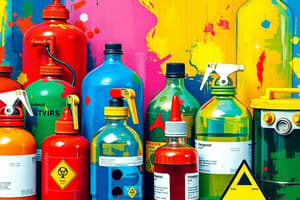Podcast
Questions and Answers
Which technique is primarily used for analyzing the causes of failures in safety systems?
Which technique is primarily used for analyzing the causes of failures in safety systems?
- Job safety analysis
- Safety surveys
- Fault tree analysis (correct)
- Safety inventory system
Which of the following rules primarily focuses on the management and handling of hazardous waste?
Which of the following rules primarily focuses on the management and handling of hazardous waste?
- Chemical Accidents (Emergency Preparedness, Planning and Response) Rules 1986
- Manufacture, Storage and Import of Hazardous Chemicals (Amendment) Rules, 2000
- Permit to work systems
- Hazardous Waste (Management, Handling and Transboundary Movement) Rules 2008 (correct)
What is the primary concept behind the establishment of a safety tag system?
What is the primary concept behind the establishment of a safety tag system?
- Maintaining an inventory of safety equipment
- Monitoring and controlling access to hazardous areas
- Implementing emergency response plans
- Communication of safety hazard information effectively (correct)
Which of the following is NOT a component of comprehensive emergency preparedness?
Which of the following is NOT a component of comprehensive emergency preparedness?
In risk assessment techniques, which analysis method uses a systematic approach of identifying potential hazards and their associated risks?
In risk assessment techniques, which analysis method uses a systematic approach of identifying potential hazards and their associated risks?
Flashcards
Hazard Identification
Hazard Identification
The process of identifying potential dangers or hazards that could cause harm to people, property, or the environment.
Risk Assessment
Risk Assessment
The process of evaluating the likelihood and severity of potential hazards and determining the risks they pose.
Fault Tree Analysis
Fault Tree Analysis
A method for identifying and analyzing potential failures in a system by working backward from an unwanted event to its root causes.
Major Accident Hazard
Major Accident Hazard
Signup and view all the flashcards
Emergency Preparedness
Emergency Preparedness
Signup and view all the flashcards
Study Notes
Plant and Equipment Safety
- Plant safety appraisal and control techniques aim to identify and manage safety risks related to equipment and facilities.
- Techniques include plant safety observation, inspections, sampling, surveys, job safety analysis, safety inventory systems, and product safety assessments.
- Permit to work systems and safety tag systems are also critical elements for controlling equipment safety.
- Loss control and damage control systems are crucial for minimizing potential harm and damage. System safety plays a vital role.
Laws and Regulations
- Specific regulations pertaining to hazardous chemicals (manufacture, storage, import) are outlined in the 2000 Amendment Rules.
- Chemical accident emergency planning and response rules are governed by the 1986 regulations.
- Hazardous waste management, handling, and transport regulations are defined by the 2008 rules.
Hazards and Risks
- Hazard identification techniques include inductive, deductive methods, Failure Mode and Effects Analysis (FMEA), and Cause Mapping Analysis (CMA).
- Fault tree analysis is another method for examining potential hazards.
- Understanding hazards and risks along with risk assessment techniques are essential components.
- Accident investigation reporting and analysis techniques are part of controlling and measuring performance outcomes.
- Hazard analysis techniques and measurements are critical procedures.
Major Accident Hazard Control
- Understanding and evaluating major accident hazards is paramount.
- Types of major accident hazards, their potential consequences, and the roles of management, local authorities, and the public in hazard control are analyzed.
- Onsite and offsite emergency planning, including case studies, are important aspects of major hazard control.
- Implementation of effective control procedures and systems is essential for preventing or mitigating these hazards.
Importance of Disaster Management
- Disaster management is a critical area focusing on the concept of emergency preparedness at local levels.
- Contingency plans and emergency planning and preparedness are key areas, also covered by international standards (ISO 14001, OHSA 18001, and OSHA's Process Safety Management).
Studying That Suits You
Use AI to generate personalized quizzes and flashcards to suit your learning preferences.
Description
This quiz covers safety appraisal and control techniques associated with plant and equipment safety. It includes discussions on safety regulations related to hazardous chemicals and emergency planning. Understanding these laws is crucial for effective risk management in the work environment.




